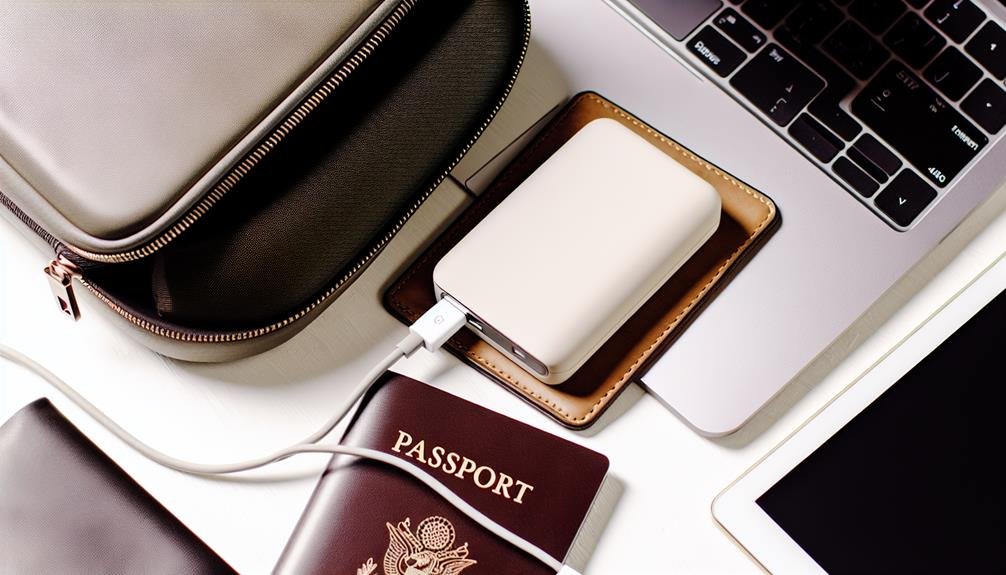Yes, you can find power banks that charge laptops. Look for those with high capacity, ranging from 20,000mAh to 50,000mAh, and make sure they support USB-C Power Delivery or DC output. Confirm your laptop's power requirements to select a compatible power bank. Also, check for safety features like overcharge protection and temperature control. Opt for energy-efficient models to minimize power consumption and prolong battery life. Prioritize lightweight and compact designs for portability. USB-C options are generally versatile and efficient, while DC outputs provide stable power. Discovering the right power bank could enhance your laptop's performance and convenience.
Power Requirements for Laptops

When selecting a power bank for your laptop, it's essential to understand your laptop's power needs to guarantee compatibility and efficiency. Begin by checking your laptop's power consumption, usually listed in watts (W) on the device or in the manual. This value gives you an idea of how much energy your laptop uses and what capacity your power bank should have to meet those needs.
Energy efficiency plays a pivotal role in your decision. Opt for power banks that maximize energy transfer while minimizing losses. This secures your laptop gets the necessary power without wasting energy, which can also extend the battery lifespan of both your laptop and power bank.
Voltage regulation is another vital aspect. Laptops typically require specific voltage levels, commonly 19V, but this can vary. Using a power bank with improper voltage can harm your laptop's internal components or reduce its battery lifespan. Hence, verify that the power bank offers precise voltage regulation to match your laptop's requirements.
Lastly, consider the long-term impact on your devices. Regularly using a power bank that matches your laptop's power consumption and provides stable voltage can help maintain your laptop's health and efficiency. By doing so, you'll secure safe and effective charging.
USB-C Vs. DC Output
Choosing between USB-C and DC output for laptop charging involves understanding their distinct benefits and limitations. USB-C is increasingly popular due to its versatility and ability to manage power delivery efficiently. Many modern laptops support USB-C, making it a practical option. It simplifies compatibility issues, as USB-C can charge different devices with a single cable. However, not all laptops are compatible with USB-C for charging, so you'll need to verify your specific model's requirements.
On the other hand, DC output offers a more traditional approach to charging. It's often used for older laptops that don't support USB-C. DC output can provide stable power delivery, but it comes with its own set of compatibility issues. You'll need to confirm that the power bank's voltage and connector type match your laptop's specifications.
Both USB-C and DC output have their advantages regarding charging options. USB-C might be more convenient and future-proof, but DC output can offer reliable power delivery for specific models. Consider your laptop's compatibility and your need for efficient battery life management to make an informed decision that aligns with your safety needs.
Battery Capacity Explained

Understanding battery capacity is crucial for evaluating how long a power bank can keep your laptop running. The battery capacity, typically measured in milliampere-hours (mAh) or watt-hours (Wh), indicates how much charge a power bank can store. A higher capacity generally means longer battery life for your laptop, but it's important to take into account your device's power consumption.
Your laptop's power consumption varies based on usage; for instance, demanding tasks like video editing or gaming will drain the battery faster than browsing the web. To guarantee safety, always check that the power bank's capacity aligns with your laptop's requirements. If your laptop has a high power consumption rate, you'll need a power bank with substantial battery capacity.
Charging speed also plays a significant role. A power bank with fast charging capabilities can quickly replenish your laptop's battery, but remember that safety features like overcharge protection are essential to prevent damage. Look for power banks that offer a balance between high battery capacity and safe, efficient charging speed. By understanding these factors, you can make an informed decision that ensures both optimal performance and safety for your devices.
Top Laptop Power Banks
When choosing a top laptop power bank, you'll want to ponder high-capacity battery options to guarantee your device stays powered throughout the day. Additionally, evaluate the portability and design, as a compact and lightweight power bank can greatly enhance your mobility. These factors will help you select the most efficient and convenient option for your needs.
High-Capacity Battery Options
For those who need a sturdy power solution on the go, high-capacity battery options are vital for keeping your laptop charged during extended periods away from traditional power sources. When considering such power banks, an important factor is the battery size. High-capacity power banks typically range from 20,000mAh to 50,000mAh or more, guaranteeing they can provide multiple charges for your laptop, depending on its power requirements.
Beyond battery size, you'll want to assess the available charging options. Look for power banks with multiple ports, including USB-C, which is becoming the norm for laptop charging due to its efficiency and versatility. Some models feature quick charge capabilities, ensuring your devices get back to full power swiftly. Additionally, check for compatibility with your specific laptop brand and model to avoid any mishaps.
Safety is another essential consideration. Opt for power banks that include built-in safeguards against overcharging, short-circuiting, and overheating. These features ensure not only the longevity of the power bank but also the safety of your laptop and other devices. To summarize, high-capacity battery options offer a reliable way to stay powered up, provided you choose a model that meets your needs and safety standards.
Portability and Design
Balancing portability and design is crucial when selecting a top laptop power bank, as you'll want a device that's both easy to carry and efficient in its functionality. You need a power bank that doesn't add unnecessary bulk to your bag but still provides enough power to keep your laptop running. This makes compact size and sleek design key factors in your choice.
Look for lightweight options that guarantee easy portability, so you can take your power bank with you without feeling weighed down. A sleek design not only looks good but typically offers better ergonomics, making it easier to handle and store. When evaluating your options, consider these essential features:
- Compact size: Guarantees the power bank fits easily into your bag or even a pocket.
- Sleek design: Provides an aesthetically pleasing look and often includes durability features.
- Lightweight options: Makes it more convenient to carry around, especially for frequent travelers.
Choosing a power bank that balances these aspects will provide you with a reliable and portable power source for your laptop. Prioritize safety by selecting models with overcharge and short-circuit protection, ensuring your device remains safe during use.
Key Features to Consider

Evaluating the key features of a power bank for laptop charging guarantees you make a well-informed purchase that aligns with your needs. First and foremost, compatibility concerns are paramount. Verify the power bank supports your laptop's voltage and current requirements. Not all power banks are created equal; some might only be suitable for smaller devices like smartphones and tablets. Check the specifications of both your laptop and the power bank to avoid any mismatches that could result in suboptimal performance or even potential damage.
Next, consider the charging options available. A versatile power bank will offer multiple ports, such as USB-C, USB-A, and possibly even a DC output. USB-C is increasingly becoming the standard for laptops due to its efficiency and higher power delivery capabilities. Having multiple ports not only provides flexibility but also allows you to charge multiple devices simultaneously, which can be particularly useful in a pinch.
Additionally, look for safety features like overcharge protection, short-circuit prevention, and temperature control. These ensure that both your power bank and laptop remain safe during use. By prioritizing these key features, you can confidently select a power bank that meets your laptop charging needs while ensuring safety and reliability.
Charging Speed and Efficiency
Charging speed and efficiency are important factors that determine how quickly and effectively a power bank can recharge your laptop. Understanding these elements helps you avoid becoming frustrated with slow charging times or inefficient energy use. In essence, you'll want to look for power banks that offer high wattage output and are optimized for laptop charging compatibility.
When evaluating power banks, consider the following:
- Fast Charging Technology: Look for power banks that support technologies like USB-C Power Delivery (PD). This helps your laptop charge quickly, reducing downtime.
- Energy Efficiency: High-quality power banks are designed to minimize energy consumption during the charging process. This not only prolongs the life of the power bank but also ensures your laptop receives a steady and reliable charge.
- Safety Features: Check that the power bank includes built-in protection against overcharging, overheating, and short-circuiting to protect your laptop.
Balancing charging speed and efficiency with safety is important. Rapid charging options can sometimes lead to increased energy consumption and potential overheating. Therefore, always confirm that the power bank you choose is compatible with your laptop's charging requirements to optimize performance while ensuring safety.
Portability and Design

When selecting a power bank for your laptop, portability and design are important factors that can significantly influence your overall convenience and user experience. A compact size is essential for those frequently on the move, making sure that the power bank fits easily into your bag without taking up too much space. This compactness doesn't just aid in portability but also in maneuverability, making it practical to carry around without adding unnecessary bulk.
Weight distribution is another critical aspect to take into account. An evenly distributed weight can prevent discomfort and strain, especially if you're carrying the power bank over long periods. Uneven weight can make the device cumbersome, impacting your comfort and potentially leading to safety concerns, such as dropping the power bank and damaging it or other belongings.
Moreover, the design should guarantee that all ports and buttons are easily accessible, even when the power bank is packed tightly in a bag. Look for models that offer a sturdy build quality, which can withstand the rigors of travel. Additionally, materials used in the power bank should be durable and ideally heat-resistant to ensure safe operation over extended usage. Prioritizing these elements guarantees a balanced and user-friendly experience.
Maximizing Battery Life
To maximize your laptop's battery life, you'll need to focus on best charging practices and reducing power drain. It's important to avoid overcharging and to use energy-efficient settings to prolong battery health. Additionally, minimizing background processes and lowering screen brightness can greatly extend your usage time.
Optimal Charging Practices
For extending your laptop's battery life, it's essential to understand the principles of best charging practices. One key aspect is maintaining charging safety and power efficiency. Always use a compatible power bank or charger to avoid potential hazards and guarantee efficient energy transfer. Power efficiency not only conserves energy but also prolongs your battery's lifespan.
Battery health is closely tied to how often you charge and discharge your laptop, known as charging cycles. Reducing the number of full charging cycles can significantly prolong battery life. Aim to keep your battery level between 20% and 80%, as extreme levels can strain the battery.
Consider these practices to maximize your laptop's battery life:
- Avoid Overcharging: Leaving your laptop plugged in after it reaches 100% can degrade the battery over time.
- Use Smart Charging Features: Many laptops have built-in features to optimize charging. Enable them to manage charging cycles effectively.
- Keep it Cool: High temperatures can negatively impact battery health, so ensure your laptop is well-ventilated during charging.
Reducing Power Drain
In addition to ideal charging practices, reducing power drain is essential for maximizing your laptop's battery life. To start, invest in energy efficient laptops that are designed to consume less power without sacrificing performance. This simple step can notably extend the time between charges.
Adopting effective power saving tips is also important. Lower your screen brightness, as high brightness settings can quickly deplete your battery. Close unnecessary applications and background processes that consume power even when not actively used. Besides, consider enabling power-saving modes available in most operating systems, which automatically adjust settings to conserve battery life.
Your laptop charging habits play a vital role too. Avoid keeping your laptop plugged in constantly, as this can reduce battery lifespan over time. Instead, aim for a balanced approach where you allow the battery to discharge to around 20-30% before recharging to about 80-90%. This practice, known as battery preservation techniques, helps maintain the health of your battery.
Frequently Asked Questions
Can a Power Bank Charge Other Devices Simultaneously With a Laptop?
Yes, you can charge simultaneous devices with a power bank if it has enough charging capacity. Confirm the power bank's portability and charging efficiency meet your needs while prioritizing safety to avoid overloading and overheating.
Are There Specific Brands Known for Reliable Laptop Power Banks?
Picture a lifeline in a storm; that's what the best brands of laptop power banks offer. Brands like Anker and RAVPower are renowned for their reliable charging capacity, ensuring your laptop's safety and longevity.
How Do Weather Conditions Affect Power Bank Performance?
Temperature impacts battery life greatly; extreme heat or cold can degrade it quickly. High humidity can affect charging speed and potentially damage internal components. Always use and store your power bank within recommended conditions for best performance and safety.
Can I Bring a Laptop Power Bank on an Airplane?
Yes, you can bring a laptop power bank on an airplane. However, airplane regulations require it to be within specific capacity limits. Verify your power bank's charging compatibility with your laptop and check the airline's guidelines for safety.
What Safety Features Should a Laptop Power Bank Have?
You'll need a laptop power bank with battery protection and overcharging prevention. These features guarantee your device's safety by preventing overheating, short circuits, and excessive charging, ultimately protecting both your laptop and the power bank itself.



